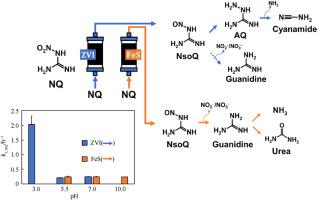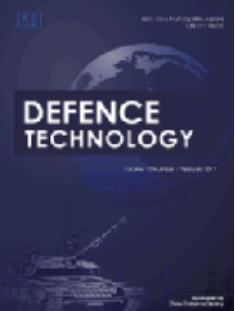用零价铁和硫化铁填料填装的连续流动色谱柱作为补救持久性污染物硝基胍的可行策略
IF 5.9
Q1 ENGINEERING, MULTIDISCIPLINARY
引用次数: 0
摘要
不敏感的弹药化合物硝基胍(NQ)被美国陆军用来避免意外爆炸。然而,NQ也是一种新兴污染物,其环境排放可能对水生生物造成毒性,表明需要有效的修复策略。因此,我们研究了用零价铁(ZVI)或硫化铁(FeS)填充的连续流塔处理NQ污染水的可行性。首先,在批量实验中评估了pH对ZVI或FeS转化NQ的影响。与ph5.5和7.0相比,ZVI在ph3.0下的NQ转化伪一级速率常数(k1, NQ)高8-10倍,而FeS在ph5.5 - 10.0下的k1, NQ值相似。根据这些发现,将ZVI填充柱和fes填充柱的进水pH分别调整为3.0和5.5。两个反应器将NQ转化为亚硝基胍(NsoQ)。ZVI进一步转化NsoQ产生氨基胍、胍和氰胺,而FeS转化NsoQ产生胍、铵和微量尿素。作为去除NQ的反应材料,ZVI的性能优于FeS。即使在运行45天后(490孔体积,PV), zvi填充柱也能有效去除未检测到的NQ。相比之下,在ffs填充柱中18 d (180 PV)后观察到NQ突破(去除效率<;85%)。zvi填充塔(>490 PV)的高NQ去除效率和长使用寿命表明,该技术是一种有前途的填料床反应器NQ处理和原位修复方法。本文章由计算机程序翻译,如有差异,请以英文原文为准。


Continuous-flow columns packed with zero-valent iron and iron sulfide as a feasible strategy to remediate the persistent contaminant nitroguanidine
The insensitive munitions compound nitroguanidine (NQ) is used by the U.S. Army to avoid unintended explosions. However, NQ also represents an emerging contaminant whose environmental emissions can cause toxicity toward aquatic organisms, indicating the need for effective remediation strategies. Thus, we investigated the feasibility of treating water contaminated with NQ in continuous-flow columns packed with zero-valent iron (ZVI) or iron sulfide (FeS). Initially, the impact of pH on NQ transformation by ZVI or FeS was evaluated in batch experiments. The pseudo first-order rate constant for NQ transformation (k1, NQ) by ZVI was 8–10 times higher at pH 3.0 compared to pH 5.5 and 7.0, whereas similar k1, NQ values were obtained for FeS at pH 5.5–10.0. Based on these findings, the influent pH fed to the ZVI- and FeS-packed columns was adjusted to 3.0 and 5.5, respectively. Both reactors transformed NQ into nitrosoguanidine (NsoQ). Further transformation of NsoQ by ZVI produced aminoguanidine, guanidine, and cyanamide, whereas NsoQ transformation by FeS produced guanidine, ammonium, and traces of urea. ZVI outperformed FeS as a reactive material to remove NQ. The ZVI-packed column effectively removed NQ below detection even after 45 d of operation (490 pore volumes, PV). In contrast, NQ breakthrough (removal efficiency <85%) was observed after 18 d (180 PV) in the FeS-packed column. The high NQ removal efficiency and long service life of the ZVI-packed column (>490 PV) suggest that the technology is a promising approach for NQ treatment in packed-bed reactors and in situ remediation.
求助全文
通过发布文献求助,成功后即可免费获取论文全文。
去求助
来源期刊

Defence Technology(防务技术)
Mechanical Engineering, Control and Systems Engineering, Industrial and Manufacturing Engineering
CiteScore
8.70
自引率
0.00%
发文量
728
审稿时长
25 days
期刊介绍:
Defence Technology, a peer reviewed journal, is published monthly and aims to become the best international academic exchange platform for the research related to defence technology. It publishes original research papers having direct bearing on defence, with a balanced coverage on analytical, experimental, numerical simulation and applied investigations. It covers various disciplines of science, technology and engineering.
 求助内容:
求助内容: 应助结果提醒方式:
应助结果提醒方式:


